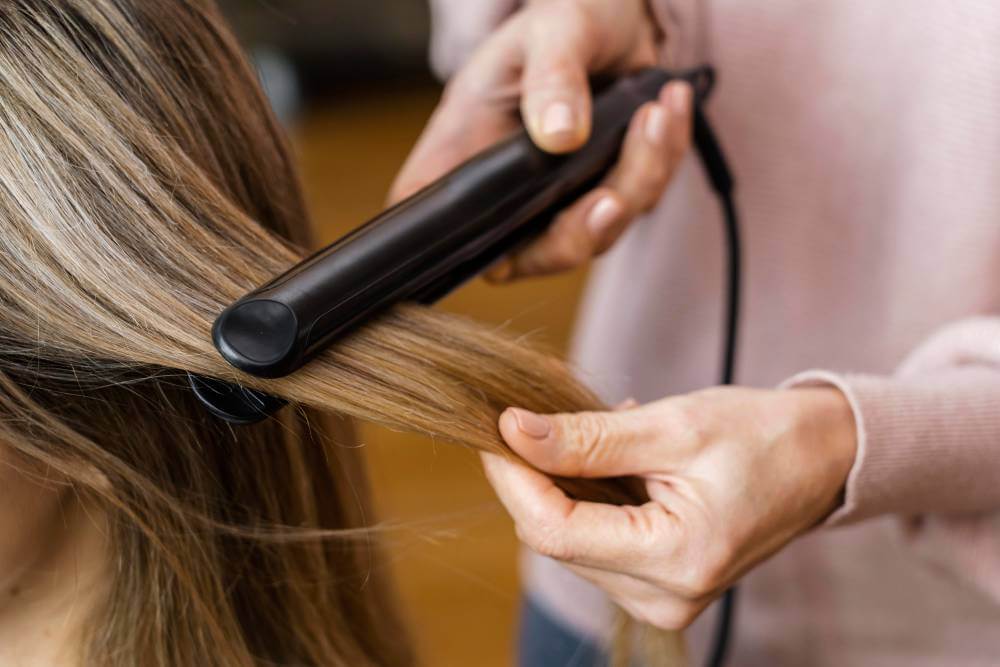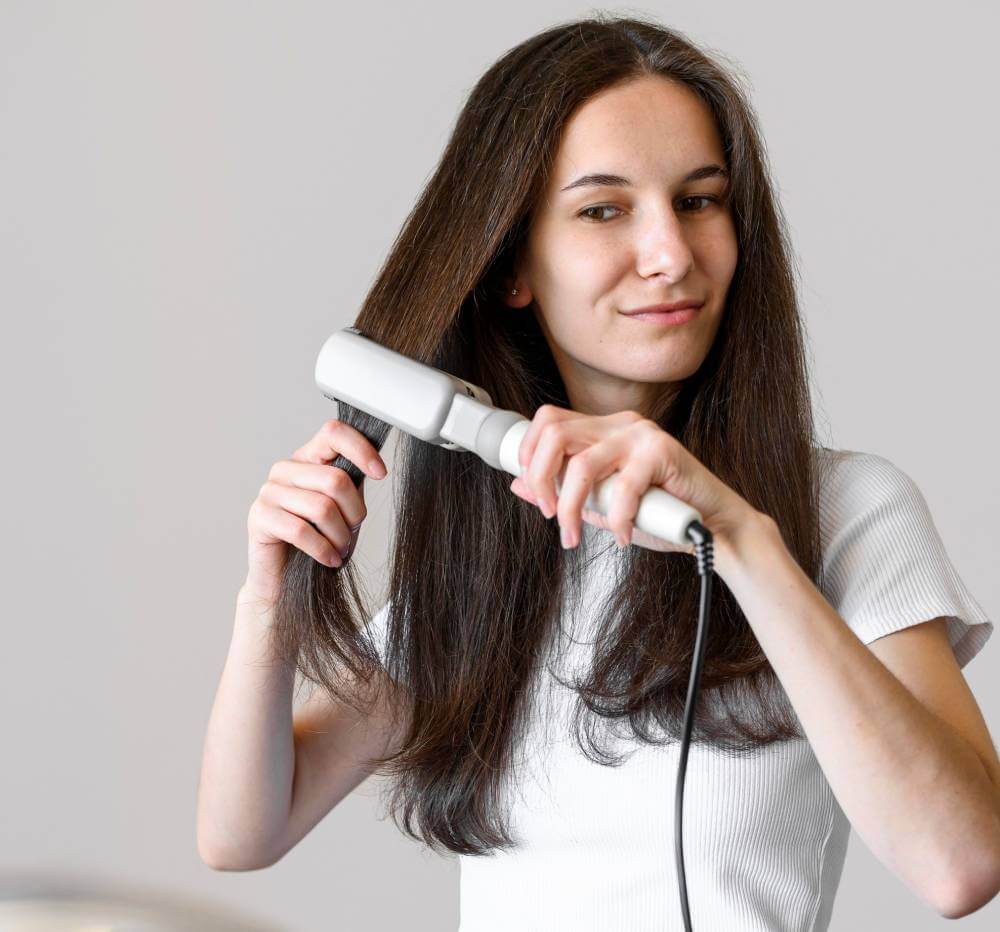The journey to achieving silky, shiny hair often begins with a bit of smoke—literally. A common issue when flat-ironing hair, particularly with curlier textures, is overheating it by cranking your tool up to 450 degrees. This is a significant hairstylist faux pas. Instead, some experts suggest that the problem may stem from the type of plates used in your flat iron. There’s a subtle yet important difference between ceramic flat irons and titanium flat irons, which can affect the final result of your styling.
The main difference between the two types of plates is how they heat the hair. Ceramic plates heat from the inside out, while titanium plates heat from the surface of the hair shaft. You may notice that your ceramic flat iron takes longer to heat up, but that’s a good thing in the long run.
Titanium flat irons heat up almost instantly but come with higher risks for your hair. “Titanium flat irons are great for professional use,” says Cheryl Bergamy, editorial hairstylist. “They heat up fast and distribute heat evenly for a smooth finish, but misuse can cause major damage to the hair.”
Another difference is the way the plates heat the hair. Ceramic flat irons use infrared technology to heat, straightening the hair from the inside out, which is generally gentler, especially for finer textures. Titanium flat irons heat the surface of the hair shaft, which can cause more damage if not used carefully.
How To Use A Flat Iron Safely?

Regardless of titanium or ceramic, many stylists agree that the most important thing is to make sure your hair is prepped and protected. It’s also essential to keep the flat iron heat to a maximum of 375 degrees. “Protecting hair during the straightening process starts in the shower,” says Laura Polko, celebrity hairstylist and Nature Lab Tokyo ambassador. “If I know I will be heat styling, it’s important to use a hydrating shampoo and conditioner and, if needed, a treatment mask that will help restore moisture to the hair, preparing it for the heat you’re about to apply.”
Prep Your Hair
I’ve found that the proper hair care routine makes a big difference in how my hair reacts to heat styling. For example, I use a sulfate-free shampoo and a moisturizing conditioner that doesn’t strip my hair of its natural oils. Sometimes, I add a deep conditioning treatment or hair mask to my routine if my hair feels dry or damaged. This extra step not only moisturizes my hair but also creates a heat barrier.
Cheryl Bergamy agrees. “I apply a leave-in conditioning cream with heat protection,” she says. Depending on how coarse or tight the curl pattern is, I may have my client sit with a plastic cap for a few minutes to infuse moisture into the hair. I’ve found this method makes the hair softer and easier to blow out without pulling, which can cause breakage. And if the hair needs it, I apply heat-protecting oil before flat ironing.”
Heat Protection
Heat protectant is non-negotiable in my hair care routine. I prefer lightweight sprays or creams that don’t weigh my hair down. I’ve found that applying heat protectant not only protects my hair from damage but also gives it a nice shine and smoothness to my finished look. It’s a small step that makes a big difference in my hair’s health and appearance.
When it’s time to straighten, be sure to use a light hand. Titanium plates are lighter than ceramic plates, which makes you think you need more passes to get the hair straight. But when used correctly, titanium can be faster and more effective, especially if you get a straightener with a heat sensor to prevent overheating.
Technique
I’ve found technique is just as important as tools and products. I like to section my hair into manageable parts, usually about one to two inches wide. This even allows heat distribution and ensures each section is appropriately straightened. I also try to move the flat iron slowly and steadily down the hair shaft to avoid overheating damage.
I also find that using a comb to guide the hair as I straighten helps to get a smoother finish. This method helps to detangle any knots and ensures that the hair is evenly distributed in front of the plates for a sleek look.
Which Flat Iron Is Better For Curls?
When it comes to styling curly hair, the flat iron you choose can make a big difference in getting the look you want without compromising the natural curl pattern. No surprise Cheryl Bergamy a seasoned stylist prefers ceramic plates for natural hair. “It’s safer, and you can control the heat temperature,” she says. “Remember, we don’t want to ruin the curl pattern, so I recommend a ceramic and ionic duo flat iron. This type of flat iron is great for infusing moisture into the hair while straightening.”
The Benefits of Ceramic Plates
Ceramic plates are known for even heat distribution, which is key to minimizing damage to curly hair. I’ve found that using a ceramic flat iron gives me a smooth finish without overheating specific sections of my hair. The ionic technology in these flat irons helps reduce frizz and add shine, making them perfect for textured hair.
Bergamy says that while a higher temperature is often needed for straightening, it’s equally important not to pass over the hair too many times. “I like to aim for 325 to 375 degrees, depending on the coarseness of the hair,” she says. This temperature range is the sweet spot between styling and hair integrity.
Temperature Control
You have to be mindful of the temperature you use and how often you apply heat. I’ve found that overusing any flat iron can cause damage, especially to the hair’s elasticity. This can cause the curl pattern to loosen over time, which I’ve experienced myself. To combat this, I try to limit my heat styling and always use a heat protectant to shield my hair from damage.
Techniques for Maintaining Curls
When using a flat iron on curly hair, technique is key to maintaining the curl pattern. Instead of straightening the hair completely, I often opt for a method called “curling with a flat iron.” This is when you twist the flat iron and glide it down the hair shaft, which helps to create soft waves while preserving the natural curl. This method allows me to get the benefits of straightening without losing my curls completely.
Also, section the hair into smaller parts to ensure even heat distribution and control. This makes the styling process more manageable and gives you a more polished look.
Ceramic or Titanium Flat Iron?

When choosing between ceramic and titanium flat irons, aesthetics and functionality play a big role in a stylist’s decision. “I’m a huge fan of ceramics,” says Laura Polko, a renowned stylist. The plates leave hair super smooth and shiny and are not harsh on the hair.” I’ve personally experienced this smooth finish with ceramic flat irons; they glide through the hair so smoothly with no friction and damage.
On the other hand, Cheryl Bergamy has a different opinion. “Actually, I sometimes go for the titanium flat iron,” she says. The silver exterior and lightweight handle look so glamorous. “I can appreciate the design of titanium flat irons; they look modern, and many users love them. But while looks are important, I think performance and hair health should be the top priorities when making a choice.
Hair Type
Bergamy says she assesses the hair before choosing any straightener. “Often, people get confused when choosing which flat iron would be best for their hair texture,” she explains. This is a big point; knowing your hair type and texture can make a big difference in your chosen flat iron. For example, I’ve found my fine hair responds better to lower heat settings and gentler styling tools, so ceramic is the better option for me.
As a stylist, Bergamy says each flat iron is unique. “I have a love affair with both titanium and ceramic,” she says. “Both have their advantages.” Titanium flat irons heat up fast and are suitable for those with thicker, coarser hair, but they can be prone to overheating if not used carefully.
Safety First
If she had to choose which one to recommend for non-professional use, Bergamy would suggest ceramic. “The reason being, I’m all about safety, especially when it comes to styling textured hair.” I agree with that. For those of us who are not professional stylists without experience or training, we should opt for ceramics. The ability to control heat settings and the gentler nature of ceramic plates make it perfect for daily use.
